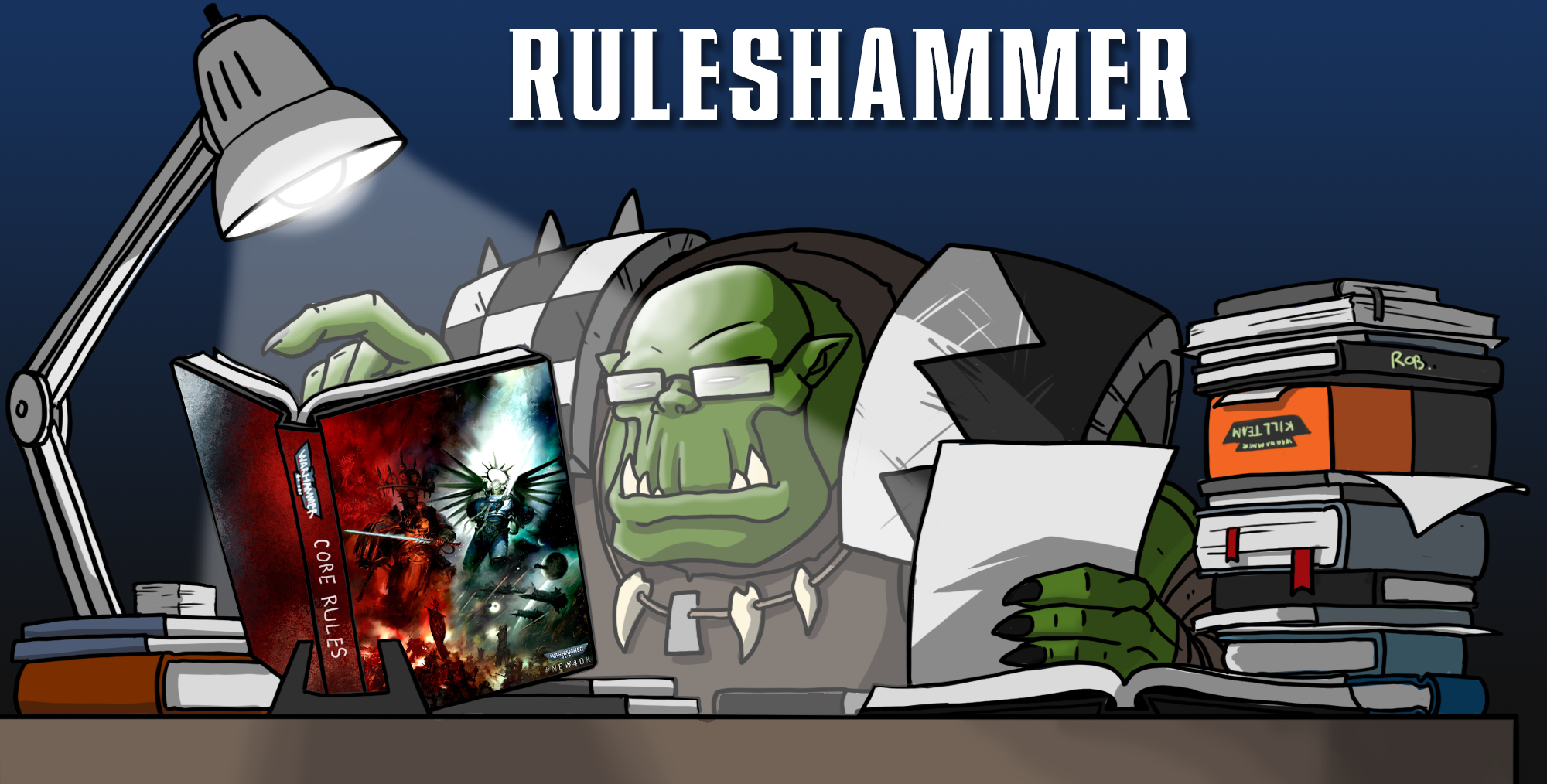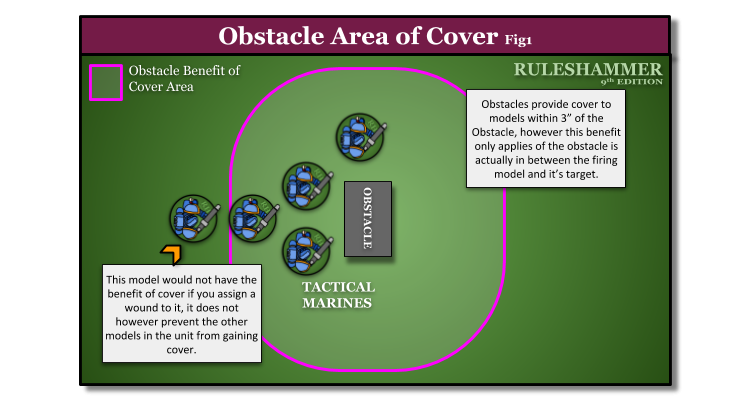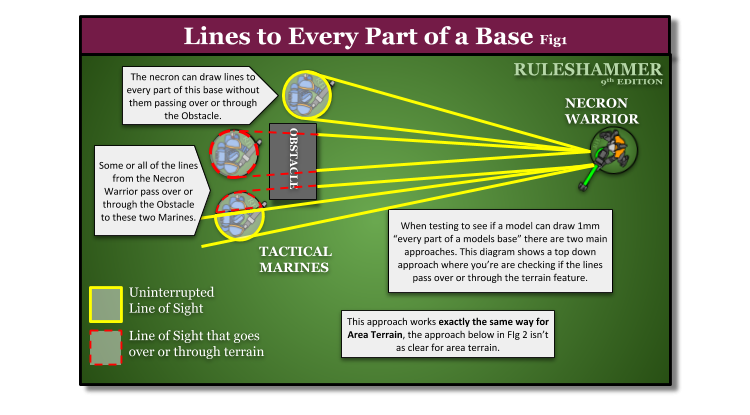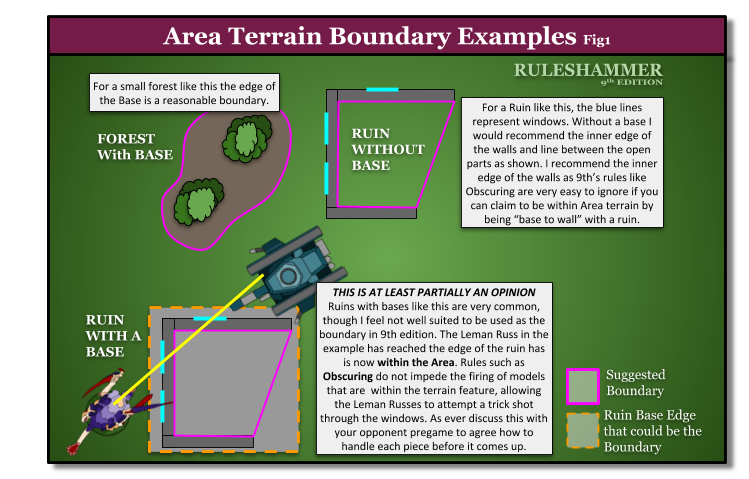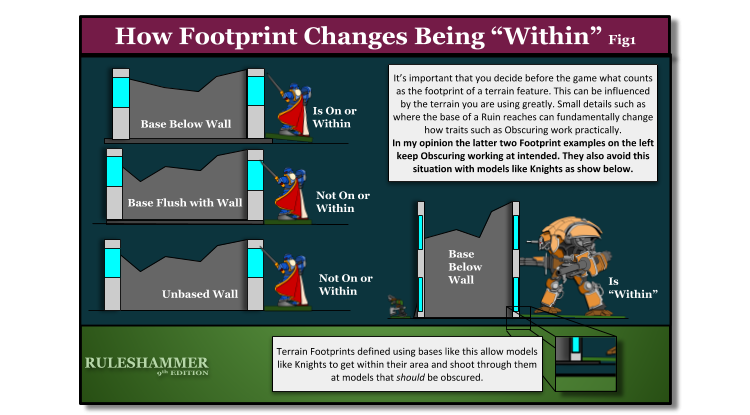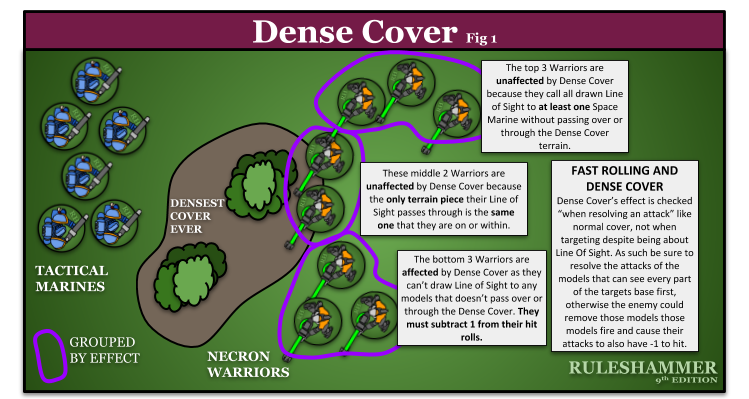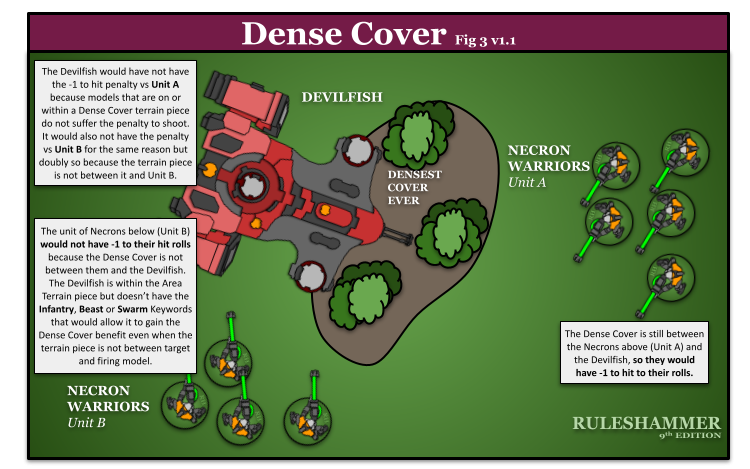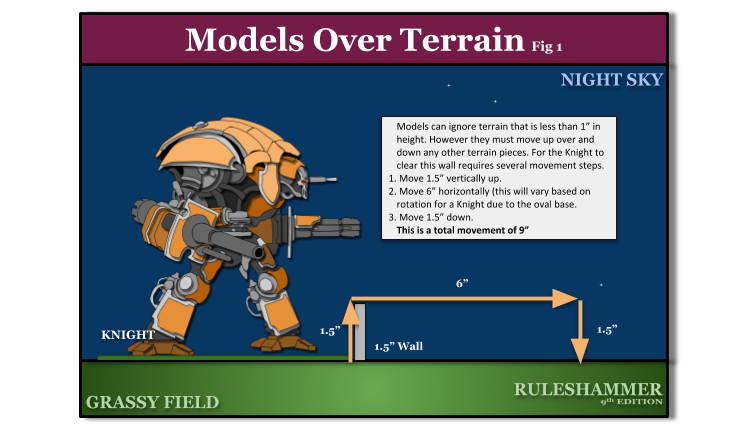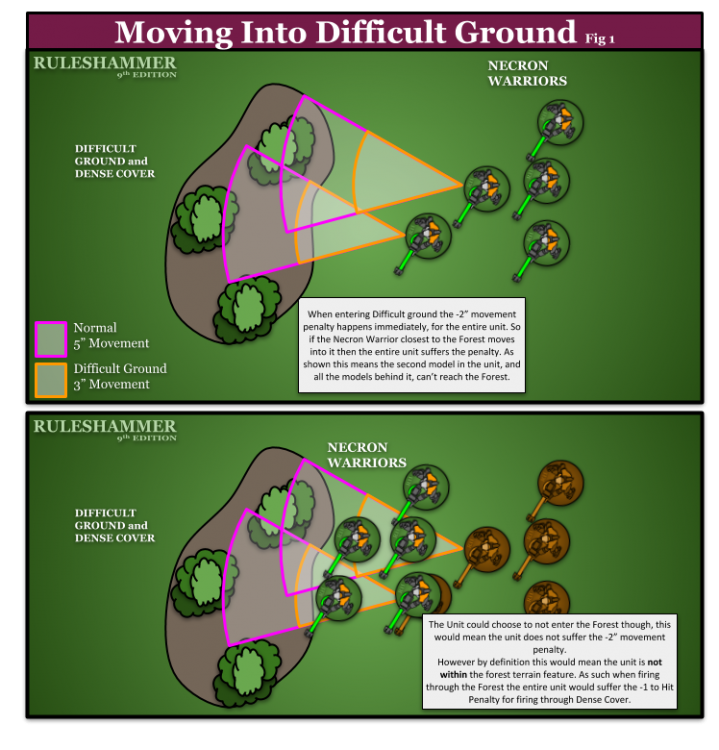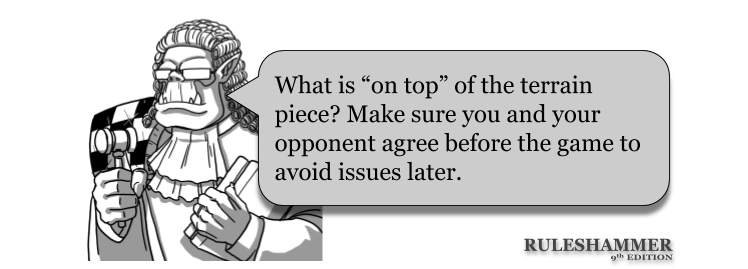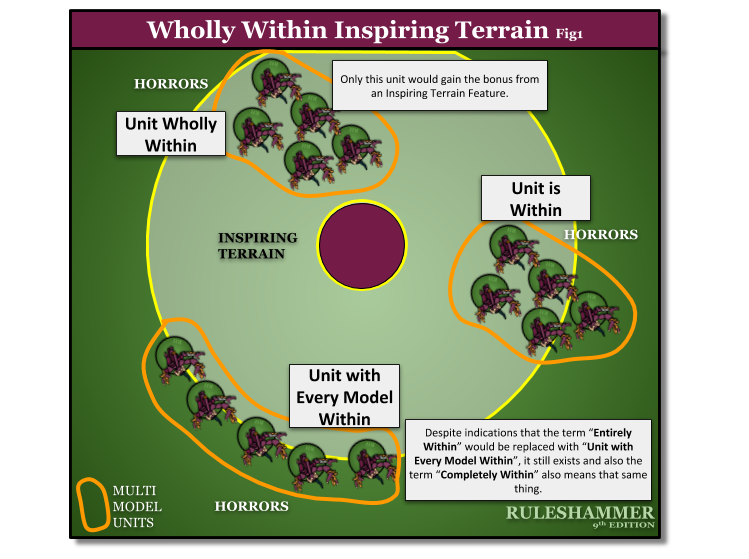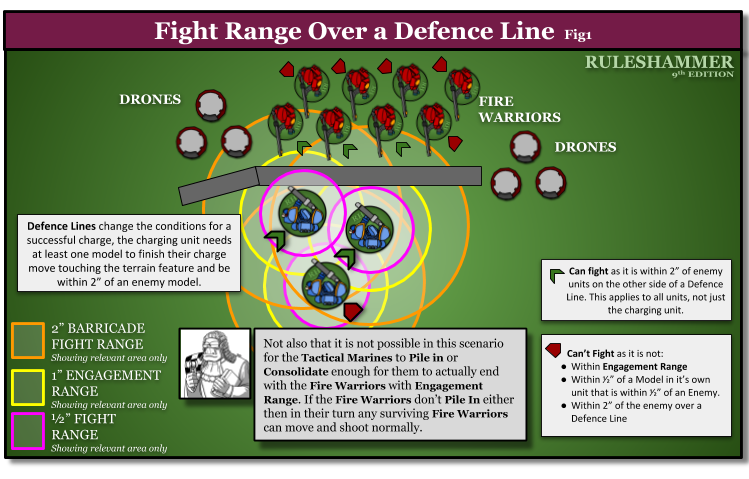Terrain is an integral part of the 40k and it’s an area that is often the cause of some of the best moments in the game and some of the most confusing too. This article aims to explain all the terrain rules for Warhammer 40k 9th edition and elaborate on any known issues.
Warning! This article is for 9th edition Terrain Rules, Ruleshammer is now covering 10th edition Terrain rules starting with this article on Ruins.
Terrain Categories
In 9th every piece of terrain must be assigned one of four categories.
Hills
Hills, whether free standing or modeled into the battlefield itself, are raise areas that offer troops on top of them commanding views of fire. Hills are always considered to be part of the battlefield itself rather than a terrain feature, and so models on top of them do not typically receive an additional benefits. Models can move over Hills following the normal rules for movement. A model on or behind a Hill uses the normal rules for determining is another model is visible to it, or if it visible another model. Hills cannot be chosen as the target of an attack. [GT2020 Pg 82]
An important consequence of Hills not counting as a terrain features is that abilities such as the Raven Guard chapter tactic that requires the unit to be on a terrain feature would not be triggered by being on a hill, as they are not considered to be terrain pieces even if they are free standing rather than sculpted into the board.
Hills come in a variety of shapes and sizes, so be sure you check with your opponent or if at an event it’s rules pack. For ease of use it’s not uncommon for some events to make hills as a stack of flat levels.
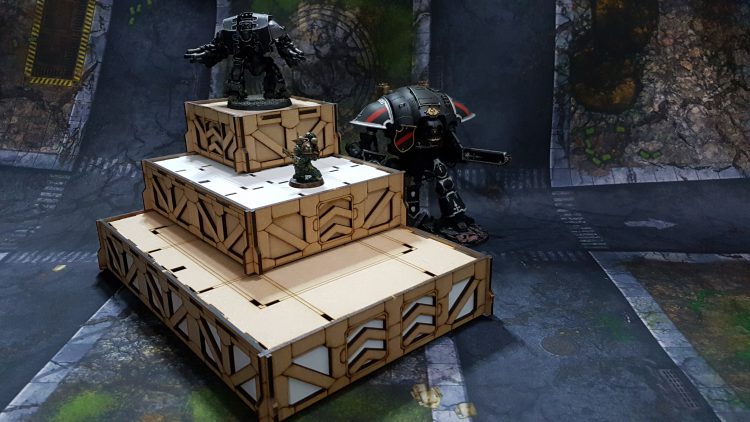
Obstacles
Obstacles include Barricades, Ruined Walls, and other Battlefield debris that models have to move over or around. Models can move up, over and down Obstacles following the normal rules for movement. A model on or behind an Obstacle uses the normal rules for determining is another model is visible to it, or if it visible another model. Obstacles cannot be chosen as the target of an attack.
An INFANTRY, BEAST or SWARM model receives the benefits of cover from an Obstacle while it is within 3″ of that terrain feature unless, when you resolve an attack that target’s a models unit, you can draw straight lines, 1mm in thickness, to every part of a models base from a single point on the attacking model’s base (or hull) without any of those lines passing over or through any part of the terrain feature. [GT2020 Pg82]
Obstacles are the smaller solid pieces of terrain like Statues, Barricades, Ruined Walls that you models have to move over or around. What’s interesting about this though is that Obstacles on their own do not define a “benefit of cover”, so if the obstacle lacks a cover Terrain Trait then it’s entirely possible whilst near them to “have the benefit of cover” and that benefit be nothing at all. Also, obstacles only provide cover to Infantry, Swarm and Beasts whilst within 3” of the obstacle, and under certain Line of Sight conditions.
…unless, when you resolve an attack that target’s a models unit, you can draw straight lines, 1mm in thickness, to every part of a models base from a single point on the attacking model’s base (or hull) without any of those lines passing over or through any part of the terrain feature. [Obstacles – Book Pg260]
You can still allocate wounds to the models in the unit that have cover though as you can for models in area terrain, just remember you have to keep allocating to a model that has had any wounds allocated to it that phase. Until that model either dies, or the phase ends.
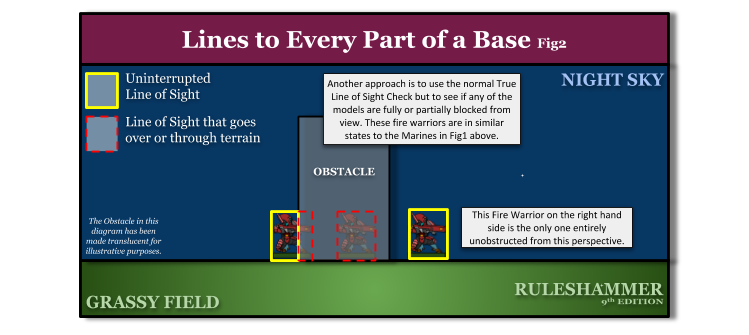
The Dense Cover Terrain trait also has a very specific set of conditions for this terrain category, which is covered later on in this article.
Area Terrain
Defining Area Terrain and it’s Footprint
Area terrain can include Ruins, Woods, Craters, and other terrain features that models can move into and through. Each time an Area Terrain feature is set up on the battlefield, both players must agree up on the footprint of that terrain feature – that is, the boundary of the terrain feature at ground level. This is essential to define so that players known when a model is wholly on or within that terrain feature when it is not. For some Area terrain features their footprint will be obvious, especially if that terrain feature has a bad or some other well defined boundary, but if not, then agree with your opponent what the footprint is. Models can move up, over and down Area Terrain following the normal rules for movement. A model on or behind Area Terrain uses the normal rules for determining if another model is visible to i, or if it visible to another mode. Area Terrain cannot be chosen as the target of an attack (but units within them can).
INFANTRY, BEAST and SWARM models receive the benefit of cover from Area Terrain whilst they are within it.
What is likely the most common type of terrain, area terrain is any terrain that covers an area. Sometimes this will be denoted by a base but it might not be or the base might be a beautifully sculpted terrain piece in it’s own right. It’s important to agree on the boundary before the game starts. [GT2020 Pg82]
I have my misgivings about this definition but at the same time I don’t really know what Games Workshop could have done other than let players agree on the footprint of terrain pieces, as the terrain used on tables varies massively and isn’t just made up of GW kits. Building terrain to create cool tables is almost a hobby within a hobby for many.
I’ve outlined a few examples of defining footprints below.
Games Workshop have however released a few new pieces of terrain with defined foot prints that do help demonstrate their intention for them.
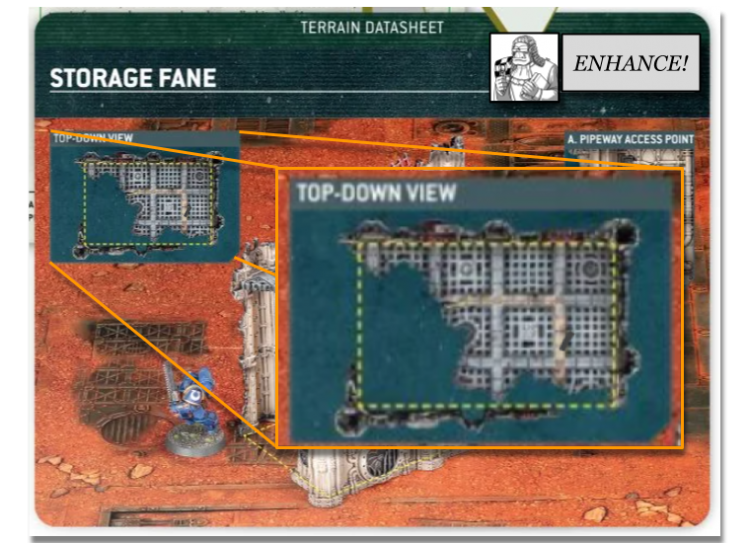
Their example clearly shows their idea for foot prints is the area enclosed by the terrain, which does in my opinion support my suggested boundaries above.
Being Within Area Terrain
What counts as being “within” area terrain, specifically how you adjudicate a model that is touching the outside wall of a ruin that is an area terrain piece, has been a subject of much discussion and debate for a long time. There is, frustratingly, no 100% answer to this as defined by the rules, but the interpretation I use and think leads to the most sensible interactions with terrain uses footprints as I have demonstrated above, and models count as within them only if part of their base overlaps that boundary by a measurable degree. This can either be because they are inside an area defined by a wall or have moved part of their base onto the base of a terrain piece where the entire base has been agreed to be the footprint.
Often “playing with intent” is very helpful when agree that a model is or is not within an Area terrain piece, it’s very rare that a model only just have enough movement to reach the footprint.
Buildings
Buildings are still typically units with the Fortification Battlefield role and the BUILDING Keyword, and that are part of a player’s army. You can find out more about Battlefield Roles in the Warhammer 40000 Core book. A model on or behind a Building uses the normal rules for determining if another model is visible to i, or if it visible to another model… [GT2020 Pg83]
Like Hills, Buildings are not usually considered Terrain Pieces in the rules, they are instead considered to be units in a players army. They follow the usual rules for Line of Sight when models are shooting around them. Their special mention here establishes that these models are not Area Terrain or Obstacles though, so it’s their datasheets that define any affects being on or around them has on a unit.
Terrain Traits
The terrain traits system allows for a wide variety of terrain pieces to be give a selection of rules that reflect how models will use or interact with them during the battle, I’ve subdivided them further into some categories of my own to help explain how they impact different parts or often phases of the game. These areas are Cover Traits, as the name implies these terrain traits define what the “benefit of cover” actually is that models can gain for being on or within their area of influence. Movement Traits is the next most common type, these traits define special ways that a model’s movement is or sometimes isn’t affected by different terrain pieces. Lastly Interactive Traits, these are traits that either give the unit abilities to use or otherwise change some facet of the normal rules for what models can do or how they interact with each other.
Cover Traits
Light Cover
When an attack made with a ranged weapon wounds a model that is receving the benefits of cover from this terrain feature, add 1 to the saving throw made against that attack (invulnerable saves are not affected).
Terrain Features commonly with this trait: Ruins, Craters, Armoured Containers, Barricades, and Pipes
What’s worth noting about this trait is that it’s not suggested in the rules that it be applied to woods, or industrial structures. Instead both of those features have Dense Cover. Also remember that models receiving the benefit of cover from Area Terrain (but not Obstacles) can use this bonus even if there are models in their unit that are not in cover. However once you take a save on such a model, you have to continue to allocate wounds to that same model until it either dies or the phase ends.
Heavy Cover
Terrain Features commonly with this trait: Barricades
When an attack made with a melee weapon wounds a model that is receiving the benefits of cover from this terrain feature, add 1 to the saving throw made against that attack unless the model that the attack is allocated to made a charge move this turn (invulnerable saving throws are not affected).
This trait provides a cover bonus to units that didn’t charge this turn, turning these terrain pieces into a strong position from which to take an enemy charge.
Dense Cover
Terrain Features commonly with this trait: Woods, Industrial Structures, Ruined Walls.
If this terrain feature is at least 3″ in height, then subtract 1 from the hit roll when resolve an attack with a range weapon unless you can draw straitght lines, 1mm in thickness, to every part of at least one model’s base [or hull] in the target unit from a single point on the attack model’s base [or hull] without any of those lines passing over or through any part of any terrain feature with this trait.
Models that are on or within an Area Terrain Feature with this trait do not suffer this penalty if the only terrain feature these lines pass over or through is the terrain feature that the attacking model is on or within. Models within 3″ of an Obstacle terrain feature with this trait do not suffer this this penalty if the only terrain feature that these lines pass oveer or through is the feature that the attacking models is within 3″ of. The height of a terrain feature is measure from the highest point on that terrain feature.
Models do not suffer this penalty to their hit rolls when making an attack with a ranged weapon that targets an AIRCRAFT unit, or a unit that includes any models with a Wounds (W) characteristic of 18 or more, even if this terrain feature is between it and the firing model (note that the reverse is not true). [GT2020 Pg 84]
Disclaimer: Dense cover is probably one of rules that is in most need of a rewrite in my opinion. Below are several diagrams and explanations for Dense Cover however they are based on interpreting the Designer Commentary Note from the Core FAQ in a particular way. GW didn’t actually amend the wording of Dense Cover to work in the way that this FAQ note suggests.
Also, in the same way that Obscuring terrain ‘blocks’ visibility when it is in between the firing model and its intended target, Dense Cover terrain imposes a hit penalty whenever it is between the firing model and its intended target (with the noted exceptions).
I read this as suggesting that the Dense Terrain piece needs to be between the firing model and the target. In the same way that an Obscuring Terrain pieces needs to be between the firing model and the target to obscure a model. However as GW have not amended Dense as mentioned the explanations below are really only a suggestion. Discuss how Dense will function pregame to avoid confusion.
So what does Dense cover do? Well the scenario it’s mostly designed to create is like this.
However it has that line about drawing lines an entire models base (or hull) so it also conveys cover in situations like this.
FAQ 1.1 has clarified that Dense Cover is intended to only need to be between the firer and the target for the benefit to apply and doesn’t have any keyword requirements in this instance. The diagrams below have been updated to reflect this.
However that’s when the models are not within the terrain, and we’re using Dense Cover’s rule on it’s own to determine if any benefit of cover is gained. What isn’t clear still is if, when models are within Area Terrain, they gain the benefit of cover if they are not INFANTRY, SWARM or BEAST or whilst the terrain piece is still between them and the firing models. My interpretation is that the diagram below is what the rules are trying to outline, but the FAQs have not actually amended the wording for Dense Cover so it’s not 100% clear.
This lovely diagram is still potentially contestable though, see our break down of why here https://www.goonhammer.com/goonhammer-hot-take-core-book-faq-round-2/
Editor’s Note: The competitive scene currently mostly comes down on the side of being partially within dense terrain being good enough to claim the bonus, even if you’re a vehicle/monster. While this can create some counterintuitive situations (see below) it reduces ambiguity, which is generally favoured in the competitive scene.
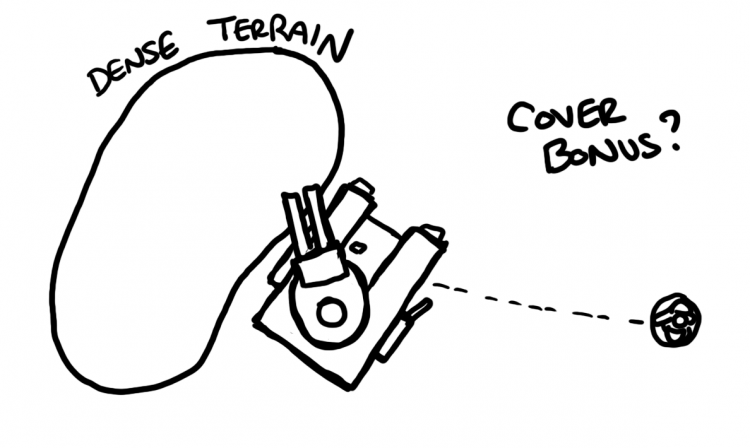
Movement Traits
Breachable
INFANTRY, BEASTS and SWARM units can move through this the walls, girders, chains and foliage of this terrain feature without impediment. [GT2020 Pg84]
Terrain Features commonly with this trait: Ruins, Woods, Industrial Structures (see Known Issues), Ruined Walls
This trait changes how models move through terrain, rather than having to account for the vertical movement necessary to clear obstacles (as demonstrated below) models with the appropriate keywords can move straight through these terrain pieces.
Industrial Structures and Breachable though, I’m not sure I 100% agree with Games Workshop on that combination. The example in the rule book is terrain like this piece below.
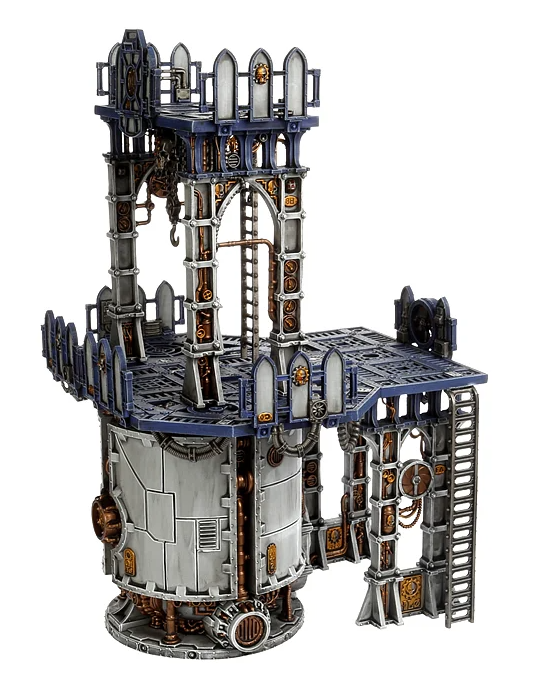
“Rules as written” giving this terrain feature Breachable would allow models to move through the enclosed tower part, there’s also an argument that there’s nothing in the rules stopping a model from stay within that space (though I think you’d be hard pressed to find an opponent that would be okay with that). Generally I’m of the opinion that these Terrain features do not actually even need Breachable, the pillars do not present a significant barrier to movement using the normal movement rules but the central section would and I think it should.
Also worth noting is that if this trait is given to a Wood then unless the Vehicle or Monster can FLY, or there is sufficient space between the trees of the wood for the vehicle to fit between them, they can’t actually move through the Wood terrain feature. It’s not actually 100% clear in the rules what a FLY model that ends it move half way through a tree is handled, though most I think would resolve it using wobbly model if there’s a place the model could balance on top of the wood’s canopy.
Scaleable
Only INFANTRY, BEAST, and SWARM models, and models that can FLY, to be set up or end a move on top of an Obstacles Terrain Feature with this trait.
Only INFANTRY, BEASTS and SWARM, and models than can FLY, can be set up or end their move on the upper floors of an Area Terrain Feature with this trait (other models can be setup or end a move on the ground floor).
INFANTRY, BEASTS and SWARM models can move through the floors, ceilings, and gantries of this terrain feature without impediment. [GT2020 Pg 85]
Terrain Features commonly with this trait: Ruins, Industrial Structures, Armoured Containers
It’s easy to consider this the vertical movement barrier (floors) equivalent of Breachable’s horizontal movement barriers (walls). Splitting them into two traits does allow players to address the Industrial Structure in a way that I’m surprised GW didn’t suggest with their examples.

By giving a terrain piece like the Industrial piece we discussed earlier (above) the Scaleable trait but not the Breachable trait you allow models to move through the gantries but not through the solid walls or girders (which they can quite easily move around anyway). This prevents issues such as “can my model is going inside this terrain now”.
Difficult Ground
If a unit makes a Normal Move, Advances, Falls Back or makes Charge Move and any of it’s models wish to move over any part of this terrain feature, subtract 2″ from the maximum distance that every model in that unit can move (to a minimum of 0″), even if every part of this terrain feature is 1″ or less in height. This penalty does not apply if every model in the moving unit can FLY.
Terrain Features commonly with this trait: Craters, Woods
Things of note about this trait is that there are 3 types of move that this trait doesn’t reduce: Heroic Interventions, Pile In and Consolidation. All of these are still 3″ (or more if your unit has an ability to extend them). One other facet to mention is when measure distances to enter these terrain pieces, remember the subtraction still applies as soon as you move in, you don’t need to be attempting to move through.
Unstable Position
Models cannot be set up or end a move on top of this terrain feature (they can move up, over and down this terrain feature, but they cannot end a move on top of it). [GT2020 Pg84]
Terrain Features commonly with this trait: Barricades, Fuel Pipes, Ruined Walls
This is an interesting one, on the one hand it could be used on some terrain to prevent someone from balancing a sniper on a spire. It’s also not clear from the wording of this rule if it includes placing models on middle floors though if the terrain feature also has the Scaleable trait I would recommend that just the very top portions of such a terrain piece are off limits.
Interactive Traits
Obscuring
Obscuring
If this terrain feature is at least 5″ in height, then models cannot see through or over this terrain feature. This means that one model is not visible to another if you cannot draw a straight line, 1mm in thickness, between them without it passing through or over any part of this terrain feature. The height of the terrain feature is measured from the highest point on that terrain feature.
Models that are on or within terrain feature can see, and can be seen and targeted normally. AIRCRAFT models, and models with a Wounds (W) characteristic of 18 or more, are visible can can be targeted even if this terrain feature is in-between it and the firing model. [Core Rules Pg263 with FAQ update]
This rule has not actually been updated with new inline wording but there is an FAQ clarifying a specific meaning for “is visible” that should be mentioned here for clarity.
Specifically, even though the Obscuring rules state that Aircraft and models with a Wounds characteristic of 18+ can be seen through Obscuring terrain, they are still only visible (and hence eligible) targets if the firing model can physically see them (so if the terrain in question is solid and opaque, they are still not eligible targets)
Terrain Features commonly with this trait: Ruins
Obscuring is the most common interactive trait players will come across. I think the easiest route to explaining it is to look at some practical examples of how obscuring works on a battlefield.
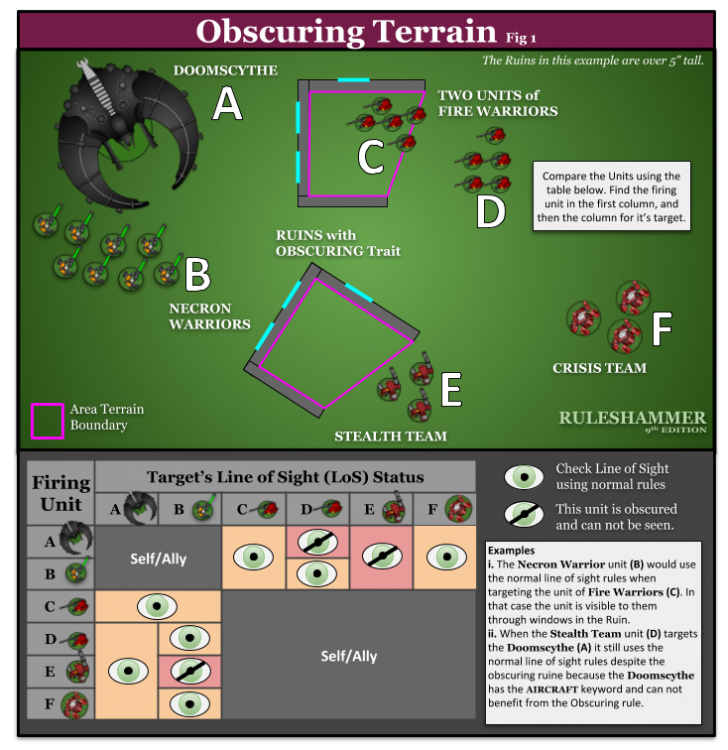
Defensible
If every model in an INFANTRY unit is on or in an Area Terrain feature with this trait then it can either Hold Steady or it can Set To Defend when an enemy unit declares a charge against it.
If every model in an INFANTRY unit is is within 3″ an Obstacle terrain feature with this trait, then it can either Hold Steady or it can Set To Defend when an enemy unit declares a charge against it if, were you to draw a straight line, 1mm in thickness, between the closest parts of the bases (or hulls) of the two closest models in the two units, that line would pass over or through that terrain feature.
A unit cannot Hold Steady or Set To Defend whilst it is within Engagement Range of any enemy units.
If a unit Holds Steady, any Overwatch attacks made by a unit this phase will hits on rolls of 5+. If a unit Sets to Defend, it cannot fire Overwatch this phase, but you add 1 to hit rolls when resolving attacks made with melee weapons by models in that unit until the end of the end of the next fight phase.
Terrain Features commonly with this trait: Ruins, Barricades, Woods, Industrial Structures, and Ruined Walls
There’s a few parts to go over with this trait. Firstly the trigger for using it is for the unit to be declared as that target for a charge. Some units have rules that allow them to join in Overwatch when a unit is charged nearby. The Tau have For The Greater Good for instance;
- Each time an enemy unit declares a charge against this unit, this unit can fire Overwatch before the charge roll is made.
- While a friendly unit with this ability is within 6″ of this unit, each time an enemy unit declares a charge against this unit, that friendly unit can fire Overwatch before the charge roll is made. If it does so, until the end of the phase, that friendly unit cannot fire Overwatch again.
Notice specifically that the unit joining in has not been charged, and is not to be treated as it was a target of the charge. So it would not get to use the Defensible trait to improve it’s Overwatch. There are others; Necron Canoptek Doomstalkers can also join in and whilst their ability does say the treat them as a target of the charge they also can’t use this benefit because they are MONSTER not INFANTRY.
Inspiring
Add 1 to the Leadership (Ld) of units while they are wholly within 6″ of this terrain feature. If this terrain has any keywords in brackets, then this bonus only applies to units that have that keyword.
Terrain Features commonly with this trait: Imperial Statues, maybe Necron Pillars, Tyranid feeding towers, or Eldar Webway portals.
Perhaps not something that you’ll see on every board, but it does allow for some Fortifications with the Building Terrain type to gain rules like this via traits rather than case by case. The wording of this rule also requires the unit to be wholly within, not just that one model from the unit be within.
Defence Line
If an enemy is within 1″ of this terrain feature, you can still make a charge move against is so long as the charging unit ends it’s charge move touching that terrain feature and is within 2″ of the target unit. Units are eligible to fight, and models can make attacks with melee weapons, if their target is on the opposite side of this terrain feature and within 2″.
Terrain Features commonly with this trait: Barricades, Fuel Pipes and Ruined Walls
This trait changes some of the fundamental ranges used in the fight phase, I’ve outlined an example below. Also when resolving fights across them they change the definition for eligible units to units that are within 2″ and on opposite sides of the terrain.
Do notice though that this doesn’t change the fight range for second rank attacks, that is still within 0.5″ of a model within 0.5″. Also if the units fail to or chose not Pile in or Consolidate to actual Engagement range, then in the charged players turn the units would not actually be in combat (assuming all the models are more than 1″ apart), the unit could make a Normal Move or Advance as usual and can shoot as well.
Exposed Position
Models never receive the benefit of cover while they are on top of this terrain feature, but they can gain the benefits of cover while they are behind it.
Terrain Features commonly with this trait: Amoured Containers
Again “on top” is not defined but the suggested types of terrain for this trait are things like storage containers which often have several different heights. I would recommend just agreeing with your opponent to treat each container separately so that they all have an “on top” of their own. There’s an element of common sense required for this rule but I also think it’s a rather sensible trait, being exposed on a high place might afford a model a good view of the enemy but it’s also very visible in return.
Known Issues
Defensible and if it’s meant to be an Unmodified 5+ for Overwatch
If a unit Holds Steady, any Overwatch attacks made by a unit this phase will hits on rolls of 5+.
Rules as written this actually does seemingly over rule the normal Overwatch requirements for hitting entirely, which would mean that this 5+ requirement would not need to be a unmodified 5 or 6. There are rules that have written that out explicitly in the past.
Tau Sept Tenet: ‘When a unit with this tenet uses their For the Greater Good ability, or when they fire Overwatch whilst they are within 6″ of another friendly T’au Sept unit, a 5 or 6 is required for a successful hit roll, irrespective of the firing model’s Ballistic Skill or any modifiers.
Despite this I think I can confidently say this this is an oversight, Overwatch and requiring unmodified rolls to hit has been a well established feature of the rule for a long time. I’d discuss this with your opponent or check the event pack for further clarification.
Troubles with Dense Cover
Rules-wise, Dense Cover is weird. I think most players are fully aware of that. The second thing of note is that it’s also a slow rolling nightmare some of the time. The reason for this is because the benefits of Dense Cover are a “per attack” check.
If this terrain feature is at least 3″ in height, then subtract 1 from the hit roll when resolving an attack with a ranged weapon unless you can draw straight lines, 1mm in thickness, to every part of at least one model’s base [or hull] in the target unit from a single point on the attacking model’s base [or hull] without any of those lines passing over or through any part of any terrain feature with this trait.
The issue here is that this can change per model during shooting on a per-Attack basis: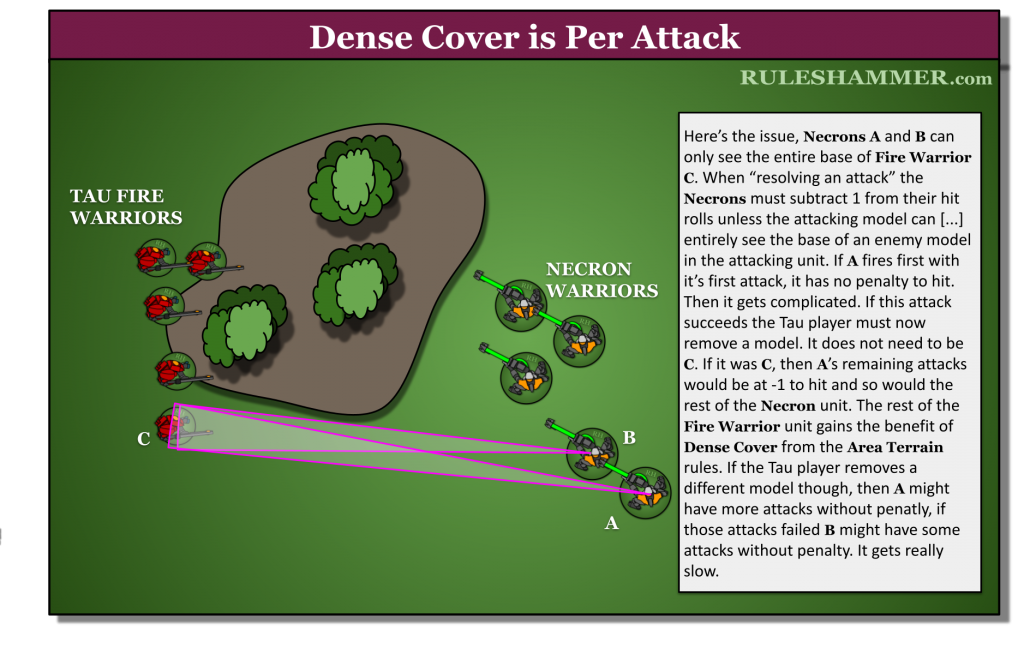
Note that this is a rather extreme example. Most of the time you’ll likely be able to group targets up so you can speed this up and still play it accurately. If the Fire Warriors unit had 3 models visible to those two Necron Warriors then you could make 3 attacks at once, for instance.
Games Workshop FAQs
Obscuring and Dense Cover
OBSCURING AND DENSE COVER
Obscuring and Dense Cover are two terrain traits introduced with ninth edition that interact with visibility. These rules do not overwrite the normal rules for determining visibility, though – they are in addition to them. Specifically, even though the Obscuring rules state that Aircraft and models with a Wounds characteristic of 18+ can be seen through Obscuring terrain, they are still only visible (and hence eligible) targets if the firing model can physically see them (so if the terrain in question is solid and opaque, they are still not eligible targets). Also, in the same way that Obscuring terrain ‘blocks’ visibility when it is in between the firing model and its intended target, Dense Cover terrain imposes a hit penalty whenever it is between the firing model and its intended target (with the noted exceptions). It is not required for a unit to be fulfilling the criteria of ‘gaining the benefits of cover’, as described for Obstacles and Area Terrain, for this penalty to hit rolls to apply (but also note that any rule that ignores the benefits of cover, or that ignores the benefits of cover that impose a penalty on hit rolls, would still ignore that penalty).
Page 263 – Obscuring, second paragraph, first sentence
Change this sentence to read: ‘Models that are on or within terrain feature can see, and can be seen and targeted normally.’
Heavy Cover Change
Page 263 – Heavy Cover
Change this paragraph to read: ‘When an attack made with a melee weapon wounds a model that is receiving the benefits of cover from this terrain feature, add 1 to the saving throw made against that attack unless the model that the attack is allocated to made a charge move this turn (invulnerable saving throws are not affected).
Ruleshammer Q&A
Have any questions or feedback? Got a rules question you want answered? Drop us a note in the comments below, ask a question in our Ruleshammer form, or head over to r/ruleshammer to discuss.
